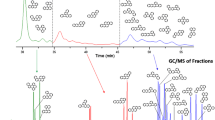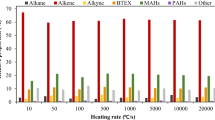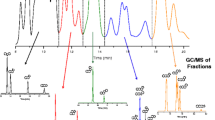Abstract
Gasification is attracting attention as a method of chemically recycling waste plastics. However, gasification generates tar, which consists primarily of polycyclic aromatic hydrocarbons (PAHs), as a byproduct. Our study aims to elucidate the steam gasification behavior of tars from acrylonitrile butadiene styrene (ABS), polycarbonate (PC), and polyethylene (PE) plastics in a batch furnace using mass spectrometry. The tar fraction varies depending on the type of plastic. The plastics tars from ABS, PC, and PE include mainly nitrogen-containing hetero-PAHs, oxygen-containing hetero-PAHs, and PAHs, respectively, reflecting their chemical structures. The formation of PAHs can be explained by the incorporation of C2 or/and C2H2 units, i.e., the 24/26 rule. The tars are found to be degraded by the addition of steam as the reaction temperature increases. Principal component analysis (PCA) indicates that the first principal component of these data, which accounts for 72% of the variance, can be attributed to the differences between the three types of plastics. A combination of time-of-flight mass spectrometry analysis and PCA enables successful discrimination of the tar components generated under gasification conditions.












Similar content being viewed by others
References
Plastic waste management institute of Japan (PWMI), PWMI Newsletter no. 47 (2018), Plastic products, plastic waste and resource recovery. http://www.pwmi.or.jp/ei/index.htm. Accessed 11 Nov 2018
Ministry of the environment, Japan (2013) Fundamental plan for establishing a sound material-cycle society. http://www.env.go.jp/en/recycle/smcs/3rd-f_plan.pdf. Accessed 11 May 2016
Zhao B, Zhang X, Chen L, Qu R, Meng G (2010) Steam reforming of toluene as model compound of biomass pyrolysis tar for hydrogen. Biomass Bioenerg 34(1):140–144. https://doi.org/10.1016/j.biombioe.2009.10.011
Kern SJ, Pfeifer C, Hofbauer H (2013) Cogasification of polyethylene and lignite in a dual fluidized bed gasifier. Ind Eng Chem Res 52(11):4360–4371. https://doi.org/10.1021/ie303453e
Arandes JM, Abajo I, López-Valerio D, Fernández I, Azkoiti MJ, Olazar M, Bilbao J (1997) Transformation of several plastic wastes into fuels by catalytic cracking. Ind Eng Chem Res 36(11):4523–4529
Xiao R, Jin B, Zhou H, Zhong Z, Zhang M (2007) Air gasification of polypropylene plastic waste in fluidized bed gasifier. Energy Convers Manag 48(3):778–786. https://doi.org/10.1016/j.enconman.2006.09.004
Nedjalkov I, Yoshiie R, Ueki Y, Naruse I (2017) Tar and soot generation behaviors from ABS, PC and PE pyrolysis. J Mater Cycles Waste Manag 58(186):234–241. https://doi.org/10.1007/s10163-016-0470-7
Arena U (2012) Process and technological aspects of municipal solid waste gasification. A review. Waste Manag 32(4):625–639. https://doi.org/10.1016/j.wasman.2011.09.025
Nunome Y, Tsuji H, Jadoon WA, Sakugawa H, Chiba S (2018) Distribution of polycyclic aromatic hydrocarbons in surface sediments of Ise Bay and Mikawa Bay. Chikyukagaku Geochemistry 52:95–105. https://doi.org/10.14934/chikyukagaku.52.95
Tanner J, Kabir KB, Müller M, Bhattachary S (2015) Low temperature entrained flow pyrolysis and gasification of a Victorian brown coal. Fuel 154:107–113. https://doi.org/10.1016/j.fuel.2015.03.069
Nguyen M, Berndt C, Reichel D, Krzack S, Meyer B (2015) Pyrolysis behaviour study of a tar- and sulphur-rich brown coal and GC–FID/MS analysis of its tar. J Anal Appl Pyrolysis 115:194–202. https://doi.org/10.1016/j.jaap.2015.07.014
Blanco PH, Wu C, Onwudili JA, Williams PT (2012) Characterization of tar from the pyrolysis/gasification of refuse derived fuel: influence of process parameters and catalysis. Energy Fuels 26:2107–2115. https://doi.org/10.1021/ef300031j
Karahaliou EK, Tarantili PA (2009) Stability of ABS compounds subjected to repeated cycles of extrusion processing. Polym Eng Sci 49(11):2269–2275. https://doi.org/10.1002/pen.21480
Liu X, Boldizar A, Rigdahl M, Bertilsson H (2002) Recycling of blends of acrylonitrile–butadiene–styrene (ABS) and polyamide. J Appl Polym Sci 86:2535–2543. https://doi.org/10.1002/app.11098
Hertz R, Streibel T, Liu C, McAdam K, Zimmermann R (2012) Microprobe sampling—photo ionization-time-of-flight mass spectrometry for in situ chemical analysis of pyrolysis and combustion gases: examination of the thermo-chemical processes within a burning cigarette. Anal Chim Acta 714:104–113. https://doi.org/10.1016/j.aca.2011.11.059
Mthembu M, Zimmermann R, Streibel T, Sklorz M (2015) Effect of temperature on the molecular weight distribution in the different ranks of coal during the on-line investigation of coal pyrolysis gas using direct photoionization mass spectroscopy. Int J Clean Coal Energy 4(4):69–80. https://doi.org/10.4236/ijcce.2015.44007
Simell P, Ståhlberg P, Kurkela E, Albrecht J, Deutsch S, Sjöström K (2000) Provisional protocol for the sampling and analysis of tar and particulates in the gas from large-scale biomass gasifiers. Version 1998. Biomass Bioenerg 18(1):19–38. https://doi.org/10.1016/s0961-9534(99)00064-1
Marvin CH, Smith RW, Bryant DW, McCarry BE (1999) Analysis of high-molecular-mass polycyclic aromatic hydrocarbons in environmental samples using liquid chromatography–atmospheric pressure chemical ionization mass spectrometry. J Chromatogr A 863(1):13–24. https://doi.org/10.1016/S0021-9673(99)00955-3
NIST Chemistry WebBook: NIST standard reference data base number 69. http://www.nist.gov/chemistry/. Accessed 30 May 2016
Pedregosa F, Varoquaux G, Gramfort A, Michel V, Thirion B, Grisel O, Blondel M, Prettenhofer P, Weiss R, Dubourg V, Vanderplas J, Passos A, Cournapeau D, Brucher M, Perrot M, Duchesnay E (2011) Scikit-learn: machine learning in python. J Mach Learn Res 12:2825–2830
Kim JW, Mun TY, Kim JO, Kim JS (2011) Air gasification of mixed plastic wastes using a two-stage gasifier for the production of producer gas with low tar and a high caloric value. Fuel 90(6):2266–2272. https://doi.org/10.1016/j.fuel.2011.02.021
Cho MH, Mun TY, Kim JS (2013) Air gasification of mixed plastic wastes using calcined dolomite and activated carbon in a two-stage gasifier to reduce tar. Energy 53(1):299–305. https://doi.org/10.1016/j.energy.2013.02.041
Font R, Aracil I, Fullana A, Martín-Gullόn I, Conesa JA (2003) Semivolatile compounds in pyrolysis of polyethylene. J Anal Appl Pyrolysis 68–69:599–611. https://doi.org/10.1016/S0165-2370(03)00038-X
Williams PT, Williams EA (1999) Fluidised bed pyrolysis of low density polyethylene to produce petrochemical feedstock. J Anal Appl Pyrolysis 51(1–2):107–126. https://doi.org/10.1016/S0165-2370(99)00011-X
Chiang PC, You JH, Chang SC, Wei YH (1992) Identification of toxic PAH compounds in emitted particulates from incineration of urban solid wastes. J Hazard Mater 31:29–37. https://doi.org/10.1016/0304-3894(92)87037-G
Tregrossi A, Ciajolo A, Barbella R (1999) The combustion of benzene in rich premixed flames at atmospheric pressure. Combust Flame 117(3):553–561. https://doi.org/10.1016/S0010-2180(98)00157-6
Zhang W, Andersson JT, Rader HJ, Müllen K (2015) Molecular characterization of large polycyclic aromatic hydrocarbons in solid petroleum pitch and coal tar pitch by high resolution MALDI ToF MS and insights from ion mobility separation. Carbon 95:672–680. https://doi.org/10.1016/j.carbon.2015.08.057
Watanabe M, Nakata C, Wu W, Kawamoto K, Noma Y (2007) Characterization of semi-volatile organic compounds emitted during heating of nitrogen-containing plastics at low temperature. Chemosphere 68:2063–2072. https://doi.org/10.1016/j.chemosphere.2007.02.022
Alston SM, Clark AD, Arnold JC, Stein BK (2011) Environmental impact of pyrolysis of mixed WEEE plastics part 1: experimental pyrolysis data. Environ Sci Technol 45:9380–9385. https://doi.org/10.1021/es201664h
Wilhelm M, Matuschek G, Kettrup A (2000) Determination of basic nitrogen-containing polynuclear aromatic hydrocarbons formed during thermal degradation of polymers by high-performance liquid chromatography–fluorescence detection. J Chromatogr A 878(2):171–181. https://doi.org/10.1016/S0021-9673(00)00266-1
Brebu M, Bhaskar T, Murai K, Muto A, Sakata Y, Uddin MA (2004) The individual and cumulative effect of brominated flame retardant and polyvinylchloride (PVC) on thermal degradation of acrylonitrile–butadiene–styrene (ABS) copolymer. Chemosphere 56(5):433–440. https://doi.org/10.1016/j.chemosphere.2004.04.002
Takasuga T, Umetsu N, Makino T, Tsubota K, Sajwan KS, Kumar KS (2007) Role of temperature and hydrochloric acid on the formation of chlorinated hydrocarbons and polycyclic aromatic hydrocarbons during combustion of paraffin powder, polymers, and newspaper. Arch Environ Contam Toxicol 53:8–21. https://doi.org/10.1007/s00244-006-0185-1
Puglisi C, Sturiale L, Montaudo G (1999) Thermal decomposition processes in aromatic polycarbonates. Macromolecules 32:2194–2203. https://doi.org/10.1021/ma981238z
Puglisi C, Samperi F, Carroccio S, Montaudo G (1999) MALDI − TOF investigation of polymer degradation. Pyrolysis of poly (bisphenol A carbonate). Macromolecules 32:8821–8828. https://doi.org/10.1021/ma9912148
Jang BN, Wilkie CA (2004) A TGA/FTIR and mass spectral study on the thermal degradation of bisphenol A polycarbonate. Polym Degrad Stab 86:419–430. https://doi.org/10.1016/j.polymdegradstab.2004.05.009
Jang BN, Wilkie CA (2005) The effects of triphenylphosphate and recorcinolbis (diphenylphosphate) on the thermal degradation of polycarbonate in air. Thermochim Acta 433:1–12. https://doi.org/10.1016/j.tca.2005.01.071
Bruinsma OSL, Moulijin JA (1988) The pyrolytic formation of polycyclic aromatic hydrocarbons from benzene, toluene, ethylbenzene, styrene, phenylacetylene and n-decane in relation to fossil fuels utilization. Fuel Process Technol 18:213–236. https://doi.org/10.1016/0378-3820(88)90048-3
Becker L, Lenoir D, Matuschek G, Kettrup A (2001) Thermal degradation of halogen-free flame retardant epoxides and polycarbonate in air. J Anal Appl Pyrolysis 60:55–67. https://doi.org/10.1016/S0165-2370(00)00118-2
Font R, Araci I, Fullana A, Conesa JA (2004) Semivolatile and volatile compounds in combustion of polyethylene. Chemosphere 57:615–627. https://doi.org/10.1016/j.chemosphere.2004.06.020
Font R, Aracil I, Fullana A, Martín-Gullón I, Conesa JA (2003) Semivolatile compounds in pyrolysis of polyethylene. J Anal Appl Pyrolysis 68–69:599–611. https://doi.org/10.1016/S0165-2370(03)00038-X
Gonçalves CK, Tenório JAS, Levendis YA, Carlson JB (2008) Emissions from the premixed combustion of gasified polyethylene. Energy Fuels 22:372–381. https://doi.org/10.1021/ef700379c
Author information
Authors and Affiliations
Corresponding author
Additional information
Publisher's Note
Springer Nature remains neutral with regard to jurisdictional claims in published maps and institutional affiliations.
Rights and permissions
About this article
Cite this article
Nunome, Y., Suzuki, T., Nedjalkov, I. et al. Generation behavior of tar from ABS, PC, and PE during pyrolysis and steam gasification by mass spectrometry. J Mater Cycles Waste Manag 21, 1300–1310 (2019). https://doi.org/10.1007/s10163-019-00883-9
Received:
Accepted:
Published:
Issue Date:
DOI: https://doi.org/10.1007/s10163-019-00883-9




